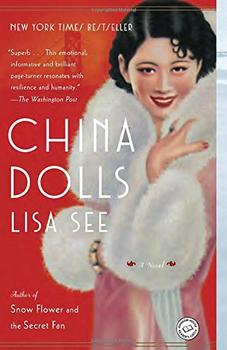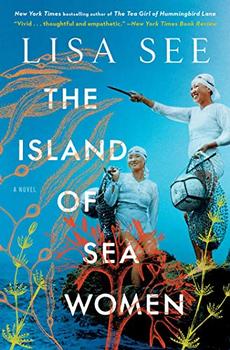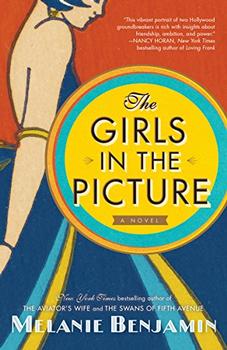Summary | Excerpt | Reading Guide | Reviews | Beyond the book | Read-Alikes | Genres & Themes | Author Bio

"Only three things cannot be long hidden: the sun, the moon, and the truth." This quotation, attributed to the Buddha, is the epigraph to Lisa See's China Dolls and gives a hint of the novel's tripartite structure: its three chronological sections are built through the alternating first-person narration of three Asian-American women. It also introduces a key thematic element of the book: searching for the truth amid lies and betrayal.
In October 1938, nineteen-year-old Grace Lee gets off a bus in San Francisco, having traveled halfway across the country from Plain City, Ohio. She looks for work at the Golden Gate International Exposition, but is told that – as an American-born Chinese – she is neither "American" nor "Chinese" enough to qualify as a dancer in their shows. "You need to do the ching-chong thing," one employer demands. But having escaped her father's beatings, Grace is too dignified to put on an accent to get work. Instead, she heads to Chinatown (see 'Beyond the Book'), where she meets Helen Fong, a widow who lives in a traditional compound with 29 relatives; and chatty Ruby Tom, who has recently moved to California from Hawaii. Before long Grace and Helen learn that Ruby is actually Japanese, but passing as Chinese to audition to be a "pony" (slang for a dancer) at the Forbidden City nightclub.
See emphasizes the fact that, although these three young women are all of Asian origin, they could not be more different. Grace's all-American upbringing completely eschewed the Chinese language and cuisine, while Helen has been totally immersed in Chinese culture despite living in America for most of her life. While Grace is homely and almost improbably naïve, Ruby is both worldly – with speech full of innuendo and sailor slang – and almost otherworldly in her beauty: "the gardenias in her hair…made her look like a glamorous crane amidst a flock of chickens," Helen marvels.
In spite of their eventual success in nightclub musical acts, they share a sense that "we'll never be accepted as Americans." Helen believes that "all three of us were alone in the world – each in our own ways. I saw, felt, an invisible string of connection tying us together." Indeed, they are linked in unexpected ways by trauma, and by romance – which traps two of them in an uneasy love triangle. I appreciated See's use of apt food metaphors, in this case to symbolize the girls' friendship: "The show kids said we went together like ginger, scallions, and garlic: put us in a pot and you get the perfect dish." Yet as they grow closer, sharing apartments and gigs, the cardinal virtue of loyalty often seems at odds with the exigencies of stardom. Especially when World War II begins and Ruby's Japanese heritage earns her suspicion and persecution, it seems uncertain whether the girls' friendship can survive its burden of secrets and duplicity.
See vividly depicts the bawdy atmosphere of the semi-nude nightclubs where the "Chinese Fred Astaire" and "Chinese Frank Sinatra" got their start. She peoples her Chinatown settings with a mixture of fictional and historical characters (Ronald Reagan and Errol Flynn make the briefest of cameo appearances), and gives intense visual descriptions of the girls' song-and-dance routines, many of which, such as Ruby's Princess Tai act, the Chinese Dancing Sweethearts, the Slant-Eyed Scandals, and the Swing Sisters, are an "Oriental mishmash." There is a self-deprecating aspect to some of these, but the documentation of racial humor may offend more sensitive readers. In an epilogue set in 1988, Helen's granddaughter accuses Grace of "perpetuating Asian stereotypes," but I believe See's intention of showing the Asian-American entertainment industry exactly as it was — good and bad — is admirable.
The strategy of dividing first-person narration three ways is less successful than it might have been. At the beginning, the three voices seem quite distinctive. Helen peppers her sections with Chinese proverbs, sounding like the mouthpiece of traditional wisdom; for example, "Even a crow loses its gait when attempting to roam like a swan" is a warning not to get above oneself. Meanwhile, Ruby fully embraces period slang: "We'd bumped gums some, talking a bit about this and that…I wasn't about to start busting out the waterworks." As the novel continues, though, the voices sound far too alike. A wonderful section of letters exchanged in 1944 goes some way toward redeeming the approach. However, I wonder if a third-person omniscient perspective might have worked better overall, or if See should have chosen just one girl (probably Grace) to be the narrator. I also feel the novel was trying to cover too much historical ground and might have been improved by zooming in on a shorter time span.
Nonetheless, it is impossible not to be impressed by the vast amount of research that went into China Dolls. From Chinatown nightclubs and a Hollywood studio to Japanese internment camps, See knows her settings through and through, and uses them as a vibrant backdrop for this touching story of three "true-heart friends."
![]() This review was originally published in The BookBrowse Review in June 2014, and has been updated for the
March 2015 edition.
Click here to go to this issue.
This review was originally published in The BookBrowse Review in June 2014, and has been updated for the
March 2015 edition.
Click here to go to this issue.

If you liked China Dolls, try these:

by Lisa See
Published 2020
A new novel from Lisa See, the New York Times bestselling author of The Tea Girl of Hummingbird Lane, about female friendship and family secrets on a small Korean island.

by Melanie Benjamin
Published 2019
From the New York Times bestselling author of The Swans of Fifth Avenue and The Aviator's Wife, a fascinating novel of the friendship and creative partnership between two of Hollywood's earliest female legends - screenwriter Frances Marion and superstar Mary Pickford.
Your guide toexceptional books
BookBrowse seeks out and recommends the best in contemporary fiction and nonfiction—books that not only engage and entertain but also deepen our understanding of ourselves and the world around us.